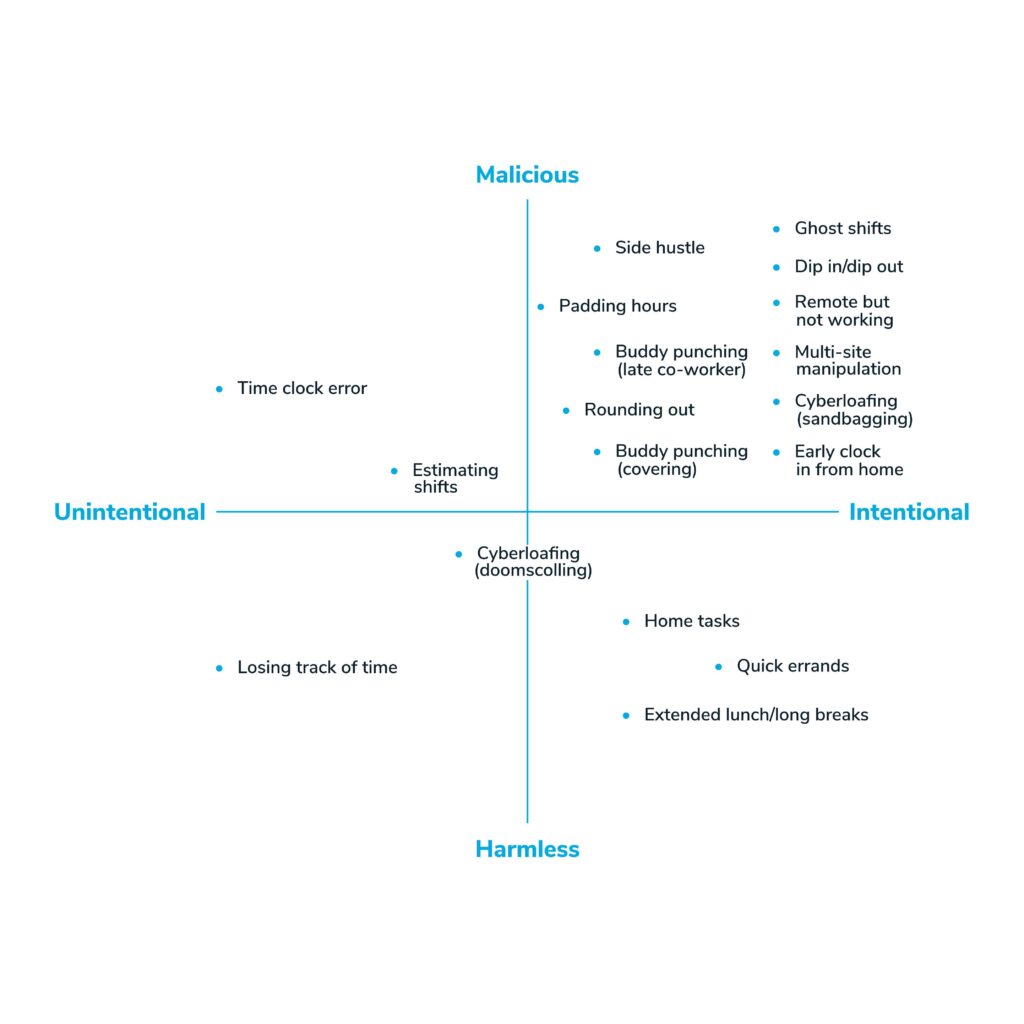Stealing is a crime, we don’t have to tell you that. But there’s a method of stealing that both employees and your organization might be unaware of: time theft. Time theft is a common and costly issue in nearly every industry — ranging from “minor issues” to “highly illegal.”
When left unchecked, time theft can lead to inaccurate payroll, low employee engagement, and lower productivity. It also increases risks for your organization such as employee turnover, compliance, and trust erosion.
So, what exactly is time theft, how does it happen in your company, and what are the implications if you fail to mitigate it? Let’s dive in.
What is time theft?
Time theft or time fraud is when employees either purposely or inadvertently:
- Say they’re at work and they aren’t
- Slack off or not work during work hours
- Inflate work hours or timesheets
While there are certainly some instances of workers intentionally stealing time from their employers, many employees don’t realize they’re doing anything wrong. Unintentional or unnoticed time theft includes accidental miscalculations of hours worked, spending time on unproductive tasks, or becoming distracted by non-work-related activities — like checking text messages or browsing the internet.
Your organization should have policies around time theft to mitigate situations if and when they occur. Even with policies in place, it’s important to understand how time theft happens in your workplace.

7 time theft examples
It’s impossible to validate or even expect that employees spend every second of their working hours on work-related, productive tasks. After all, people are people — distractions happen, interruptions are normal, and energy fluctuates.
However, when reasonable functional patterns become unreasonable dysfunctional behaviors, your company pays for it. Here are some ways employees commit time theft that you should look out for:
1. Buddy punching
One of the most common instances of time theft is buddy punching — when an employee clocks in for a coworker who is either late or absent. While buddy punching is highly intentional, it’s not always malicious.
Employees may ask coworkers to clock them in or out if personal urgencies arise, like a flat tire or a sick babysitter. Buddy punching is especially easy to get away with using old-school time punch cards as outdated employee scheduling systems do little to prevent colleagues from punching in for each other.
Here are some real-world examples of buddy punching time theft:
- Helping out a late coworker — Clocking in for a friend stuck in traffic or parking
- Covering — Clocking someone out on time who needs to leave early
- Forgotten credentials — Clocking in someone present, but who forgot their ID or badge
2. Extended breaks or lunches
Breaks are essential to working efficiently; some union collective bargaining agreements (CBAs) even require them. However, it’s not uncommon for employees to lose track of time and take an extra 10-15 minutes to get back to work.
Extended breaks and lunches are especially prevalent without time clocks to hold teams accountable. Although this time theft seems minor and is usually unintentional, longer breaks compound into significant lost time over weeks and months.
Here are some real-world examples of extended break/lunch time theft:
- Losing track of time — Taking a longer break unintentionally due to distraction or fatigue
- Regularly stretching lunch — Consistently going over break times without reporting it
- Team culture of long breaks — Taking extended coffee breaks because “everyone does it”
3. Cyberloafing
While the internet may be needed for work, it’s also the gateway to endless distractions for employees. Cyberloafing is scrolling social media, shopping online, and doing other internet-based non-work activities during work time.
Like most types of time theft, cyberloafing is not usually intentional. Getting distracted or losing track of time while cyberloafing is easy, especially without a reliable time tracking system. But with a structured process for tracking time, employees can more effectively plan their workloads and avoid the cyberloafing spiral.
Here are some real-world examples of cyberloafing time theft:
- Quick checks that become doomscrolling — Intended as a 2-minute mental break on social media, but turns into 15–30 minute stretches
- Actively avoiding work — Watching videos or playing games while appearing to work
- Sandbagging — Making tasks or projects take longer than necessary to make time for distractions
4. Ghost shifts
One of the most severe types of time theft, ghost shifts, occurs when an employee is clocked in — usually through buddy punching or remote access — but isn’t physically present at work. In extreme cases, managers or payroll staff may even fabricate hours for a “ghost employee” in exchange for favors or shift swapping (internal fraud).
Ghost shifts occur due to disconnected systems, such as scheduling software that does not sync with time tracking systems, or disorganized oversight, like employees in remote field roles gaming the system.
Here are some real-world examples of ghost shift time theft:
- Dip in, dip out — Clocking in and/or out without being seen
- Remote but not working — Logging in via app or computer but clearly inactive or offline
- System auto-punch — Automatically punched in due to flawed scheduling software
5. Inflating work hours (timesheet falsification)
On top of a full-time job, employees using manual or electronic timesheets have to track and document their working hours. This is a time-consuming and error-prone process — and one that often leads to instances of inflated work hours.
Without automated time collection processes, employees easily forget when they clocked in or out, especially during busy periods. Then employees have to estimate timesheets later, potentially padding their hours and falsifying pay for unworked time.
Here are some real-world examples of inflated work hour time theft:
- Padding hours — Reporting a 5:00 p.m. end time when they left at 4:45 p.m., or an 8:00 a.m. start time when they arrived at 8:20 a.m.
- Estimating shifts — Filling out hours later from memory and erring in their own favor
- Rounding out — Knowingly reducing break or lunch times to inflate their paycheck
6. Personal activities
In physical offices, employees might take a call or check texts during work hours. Because they cause minimal disruption, most organizations don’t consider them time theft.
However, it’s easy for personal activities to leech away at time and productivity, especially for remote, over-the-road, or multi-site employees. Without an automated time tracking system to stay on track and accountable for tasks, it’s for employees to commit time theft (intentional or not).
Here are some real-world examples of personal activity time theft:
- Quick errands — Handling out-of-home to-dos during work hours, planning to make up time later
- Side hustle — Working on a personal project or freelance while on company time
- Home-tasking — Excess handling of childcare or family needs during paid time
7. Misusing mobile clocks
For employees who work outside of the office, mobile clock misuse is a tricky example of time theft. Many mobile clocks offer convenience for employees in the field or in multiple locations, but don’t always make it clear where the employee is when they clock in.
So, while employees may be “on” their assigned job site, they might also be clocking in while they run a personal errand. Because this type of time theft is difficult to spot without geofencing and geolocation capabilities — and even harder to prove — it often goes unnoticed.
Here are some real-world examples of mobile clock misuse time theft:
- Clocking in from home — Logging time before beginning actual work, often while getting ready or commuting
- GPS error or location drift — Time clock falsely registers employee at the work location due to signal inaccuracies or gamification
- Multi-site manipulation — Using location flexibility to claim hours at one job site while working another
Consequences of time theft
With scenarios that range from nearly harmless to borderline illegal, time theft has no shortage of nuance. Neither does its impact. Each type of time theft can impact your organization’s finances, trust, morale, productivity, compliance, and/or legality.
Financial losses
If time is money, then time theft is losing money. Even small time theft increments add up to thousands annually per employee.
Say the average time theft per employee is 10 minutes per day — this might not seem like enough to worry about, right? But the time theft per year per person would be roughly 41 hours or around a week’s wages. For every 50 people on your team committing time theft daily, you’re paying enough empty wages for one full-time employee.
Reduced productivity
Lost work hours directly impact final output. But it’s not just the obvious productivity losses that matter, like missed deadlines. Workers not committing time theft will have to assume the extra burden due to time theft slack, ultimately hurting total productivity and output sustainability.
Morale and cultural erosion
Those not gaming the system notice time theft the most and resent leadership if it goes unpunished. A “no one gets caught” culture catches on, which creates disengagement, harms trust in leadership, and encourages mimicry for time theft.
Compliance and legality
Time theft introduces several potential risks for your organization: Fair Labor Standards Act (FLSA) violations, state labor law misconduct, and corrections for inaccurate pay. Employees incorrectly documented as overworked can also trigger violations of shift work time regulations.
However, the risk isn’t entirely on you as an employer. For employees, intentional time theft can be considered illegal (wage fraud, especially if coordinated). Internal consequences for time theft depend on the organization and the circumstances. Employers may issue warnings, or for intentional and ongoing issues, employers might dock pay or terminate the employee.
What to do about time theft
It’s clear that although there are several types of time theft, they all have a couple of shared characteristics: they can happen by accident, the severity of each is case by case, and they’re difficult to identify.
Recognizing and addressing time theft is the first step in stopping it before it leads to serious consequences. Having a time theft policy and clear paths to disciplinary measures helps take the guesswork of what to do when time theft happens. But what about getting ahead of time theft altogether?
Check out our article to learn how to prevent time theft before it happens.
TCP Software’s employee scheduling and time and attendance solutions have the flexibility and scalability to suit your business and your employees, now and as you grow.
From TimeClock Plus, which automates even the most complex payroll calculations and leave management requests, to Humanity Schedule for dynamic employee scheduling that saves you time and money, we have everything you need to meet your organization’s needs, no matter how unique. Plus, with Aladtec, we offer 24/7 public safety scheduling solutions for your hometown heroes.
Ready to learn how TCP Software takes the pain out of employee scheduling and time tracking? Speak with an expert today.



